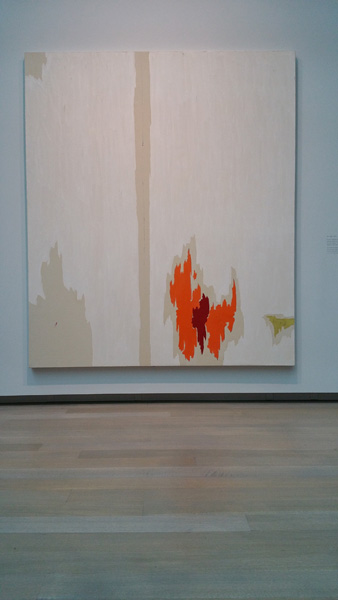Imbolc New Valentine Moon
We started our Sunday at the Clyfford Still Museum. A chamber music quartet played in Gallery 5. Their audience which carried some nifty aluminum gallery chairs to the room filled the gallery. They were appreciative, too, but, as Kate pointed out, they clapped after every movement. Not the mark of a sophisticated crowd.
I took the opportunity to wander through this small museum, listening to the music as I tried to get a read on Clyfford Still. A few of his later works were wonderful, brave. A favorite featured a huge, mostly blank canvas, with just a few yellow marks flying up like a flame burning mysteriously, some white, splashes of orange and a few scarlet intrusions from below.
I sat for a while in the gallery next to the one where the music played looking at the painting below. Somehow, I don’t even remember how now, I became a chamber music fan. For seventeen years I went to the St. Paul Chamber Orchestra, attending most concerts in their season with a subscription.
I’m not a sophisticated listener from a musical point of view. That is, I don’t really follow the construction of a piece, nor do I understand the intent a composer may have had. Not an impediment. This music reaches inside my rib cage and squeezes my heart. Often, I would sit, eyes closed, watching small sparks, sometimes large ones, dance behind my eyelids, called into existence by a note, a run, a solo performance, a particular melody.
Other times a profound sense of melancholy would overtake me, followed by jubilation. With Charles Ives’ pieces, he’s a particular favorite of mine, a small crack in the fabric of space-time could open to reveal just a glimpse of what lay beyond this moment.
I mention this because while I sat in the gallery yesterday, a question, not an original one by any means, came to me: what is the difference between music and painting? Both are art forms. Both with artists engaged intimately. Both requiring tools for the artist. Both appealing to a desire (or need, even if undiscovered) to see or hear the world in a new way, a way not possible in the everyday. Both requiring some seriousness in the listener or the viewer, some attention to the work, some willingness to be vulnerable. Both chamber music and abstract art with long histories.
Yet the differences were stark. The music floated through the galleries, taking up aural space everywhere, yet visible nowhere except Gallery 5 and even there only the artists and their tools could be seen: cello, violins, viola. One of the wonders of music is that we can see the musicians at work, bow in hand, reed wet, embouchure quivering yet we cannot see what they make. So music is invisible and painting very, necessarily visible.
Also, music is ephemeral. A painting, with appropriate conservation, can last centuries, even millennia. Once a note, a run from the quartet was heard, it died away and others filled in behind it, the linear drive of the music creating a certain expectation, a sense of beginning, middle and end. Still painted this canvas in 1972. With the exception of some possible changes to the linen and the paint-and I don’t know if there have been any-this work looks now like it did when he laid down his brush. So a painting is in that sense static.
That static nature of a painting is, in fact, a part of its meaning. We have confidence that we stand before what the artist intended; so a painting provides a moment, unmediated by others, when we as viewers can connect personally with the expressive power of a person often long dead, think Fra Angelico or Rembrandt or Poussin. Still died in the early 1970’s.
Music, in contrast, requires mediation, at least in chamber music. We hear, usually, not one artist, but many interpreting through their instruments the musical idea of a composer no longer able to comment on his or her intention. And we hear that interpretation, in the instance of live music, only once.
But, and here was an idea that was new to me, I might leave a concert whistling a melody or a particular portion of a composition. I might remember much of it, be able to recall the work as I go on from the concert hall. But, in the instance of abstract art, it is very difficult to recall what I’ve seen. The lack of representation of things familiar leaves my mind adrift when it comes to recall. This may, of course, be just me, but I imagine not.
So in this aspect, interestingly, the abstract painting becomes ephemeral, seen, then not recalled or recalled poorly, while a symphony or a concerto or a smaller chamber piece might remain, at least in part, accessible long after being heard.
In this case the apparent distinctive elements of stability and ephemerality are reversed, music being memorable, no longer ephemeral, and painting being unstable, as impermanent as the music I listened to yesterday in the gallery.


